Miss Gertrude Alger was a very young poet of merit, who produced some graceful and finished poems. Born in Yarmouthport, Massachusetts on May 19, 1868, she died October 25, 1889, at the age of twenty-one. These poems were arranged by her mother. This memorial volume is Gertrude's only published work. Poems are presented by year of composition 1882-1888. One or two of her poems found their place in late nineteenth century collections of contemporaneous poetry.
1885 poem titled:
Summer Rain
Spirits of the summer shower,
Tiptoeing from flower to flower,
Here and there, and everywhere,
tripping! tripping!
In between the petals fair
Of the blossoms, slipping, slipping!
Dancing over
Rosy beds of nodding clover!
And I hear - or is it fancy?
All the garden flowers dipping,
Swaying, tipping;
Every rose and purple pansy
Curtsying, now here, now there,
Light as air;
Bending low its pretty head
'Neath the shower-spirits' tread.
View and/or purchase this book @ My Bookstore
The Book Scene
Sunday, September 11, 2016
Monday, June 30, 2014
Drawing of Robert McKittrick Jones 2nd
In cataloging the book Constructive Anatomy, I was wondering how great a drawer Robert McKittrick Jones 2nd was. So I did a check on his past:
Fathers Silent About Katherine Morton, 16, and Robert McK. Jones, 18.
Katherine Morton and Robert McKittrick Jones, whose elopement to Toronto, Canada, was forestalled yesterday by Chicago police on information from the parents, were brought back to St. Louis today by their fathers, Stratford Lee Morton, 107 Joy avenue, Webster Groves, and Hugh McKittrick Jones of McKnight road, St. Louis County.
Neither father would discuss the elopement or future plans for the young students, except to remark that the youth of both was the only serious object to the marriage.
Robert is a Harvard freshman, 18 years old, and Katherine, 16, is a senior at the John Burroughs School, from which Robert was graduated last summer. They had been sweet hearts but chafed under parental restraint and decided on the elopement to Canada where they had planned to be married and to find employment.
Unbobbed Tresses Prove Her Undoing
Chicago. Nov. 10 1927.—The brown hair of Kathryn Morton. 16-year-old daughter of a wealthy St. Louis insurance man proved her undoing when she alighted from a train here with Robert McKittrick Jones, 18, Harvard freshman who intended to marry her. A detective, who had been notified of the couple's elopement, recognized the long-haired, unrouged girl instantly from the description of her. Jones, also the son of wealthy St. Louis parents, said they had decided to elope because, their parents would not let them marry at home. The fathers of the elopers claimed them at the police station last night and started back with them on the same train.
So Robert McKittrick Jones was shattered. The Constructive Anatomy book was brought with him from F. Weber Co. in St. Louis all the way to Harvard. A year and a half later, the final story came out:
Webster Girl Who Eloped in 1927 Weds in
Arizona
The marriage of Miss Katherine Ysabel Morton and Mitchell D. Follansbee, Jr., of Chicago, in Tucson, Ariz., March 2, was announced yesterday by the bride’s parents, Mr. and Mrs. Stratford Lee Morton of 107 Joy avenue, Webster Groves.
Mr. and Mrs. Morton were in Florida when they received a wire from their daughter of her marriage plans. The parents wired back their consent, Morton said.
Elopement Was Stopped.
Miss Morton, who is 18, attracted attention when she and Robert McKittrick Jones, son of Mr. and Mrs. Hugh McKittrick Jones of Clayton, eloped to Chicago, November 8, 1927. They were stopped by Chicago police at the request of their parents, and Jones and Morton went to Chicago and returned with the young couple.
Miss Morton was then a student at the John Burroughs School., and young Jones, a former student at the school, was then a freshman at Harvard.
Last summer Miss Morton spent her vacation on a ranch in the West and became interested in mining engineering. Last fall she obtained the consent of her parents to study engineering at the University of Arizona.
Follansbee, 23 years old, is the son of Mr. and Mrs. Mitchell D. Follansbee of Chicago. His father is a prominent attorney there, a past president of the Chicago Bar Association and had also been a member of the Board of Overseers of Harvard University.
Young Follansbee attended Harvard University for three years and is now completing a course in mining engineering at the University of Arizona. He expects to take a position with an Arizona mining concern following his graduation.
The young couple first became acquainted as students at the university.
Parents Gave Consent.
Mr. and Mrs. Morton were surprised by their daughter’s announcement of her plans to marry. But as Miss Morton had passed her eighteenth birthday and since they approved of her future, they gave their consent. The wedding was originally planned for last Wednesday, but was advanced to March 2, the date of Mr. and Mrs. Morton’s wedding anniversary.
Follansbee and Mrs. Follansbee are still pursuing their studies, and Mr. and Mrs. Morton plan to visit them this spring
It seems that the clownish figure he drew was more like himself!
Monday, December 23, 2013
Diantha Goes the Primrose Way and Other Poems
Diantha Goes the Primrose Way and Other Poems
Harper & Brothers 1920 New York and LondonA manifestation of 'The Rare New Poetry'. Critically praised poetry. A vivid little drama of a woman's soul, intense, convincing and realistic in the best sense, full of power and artistic self-restraint. The scenes are as vivid as lightning.
Two Trains Speeding Through the Night.
Two trains rushing through the storm;On one, the friend whose golden ring I wear
Goes from me, fortune-gathering in the West;
Toward me on the other
Speeds my lover.
Does the noise of elements conflicting
Disturb my husband's sleep?
Does any presage of his honor's loss
Pursue his mind throughout its dream?
Does the noise of elements conflicting
Disturb my lover's sleep?
Or, impatient, does he lie awake,
Waiting for me and the dawn?
I toss upon my warm, safe couch at home.
My soul in direst conflict
Utters smothered cries.
The wind shrieks; the rain beats
Against my window-pane.
Which wins, when love's so great, 1
And duty seems so small?
Two trains rushing through the storm.
How writhes my soul alone!
Wednesday, October 23, 2013
Coffee, A Poem
Hail, Coffee !
COFFEE affords a good restoring draft,
Which clears the fumes of wine too freely quaffed.
By her you gain, when you the table quit,
A calm more courteous, and a brighter wit;
And soon recovered, by her powerful aid,
You are not of a second feast afraid.
She by the god of verse is praised and loved;
The poet’s genius is by her improved.
Your frigid rimers, if at times inspired,
Write their best lines by coffee’s fragrance fired.
She can enliven philosophic plan,
And make an analyst a pleasant man.
Statesmen, through her, well feasted and content,
Form happy schemes of better government.
Knowledge sometimes to journalists she brings
Of court intrigues, and deep designs of kings.
Peace, truces, wars, she to his dreams can show,
And lets him, for three pence, the world o’erthrow.
Jacques Delille [1738-1813]
COFFEE affords a good restoring draft,
Which clears the fumes of wine too freely quaffed.
By her you gain, when you the table quit,
A calm more courteous, and a brighter wit;
And soon recovered, by her powerful aid,
You are not of a second feast afraid.
She by the god of verse is praised and loved;
The poet’s genius is by her improved.
Your frigid rimers, if at times inspired,
Write their best lines by coffee’s fragrance fired.
She can enliven philosophic plan,
And make an analyst a pleasant man.
Statesmen, through her, well feasted and content,
Form happy schemes of better government.
Knowledge sometimes to journalists she brings
Of court intrigues, and deep designs of kings.
Peace, truces, wars, she to his dreams can show,
And lets him, for three pence, the world o’erthrow.
Jacques Delille [1738-1813]
MARBLED PAPER PATTERNS
http://content.lib.washington.edu/dpweb/patterns.html
Paper Patterns
MARBLED PAPER PATTERNS
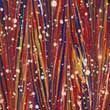 | Antique straight Wolfe: Antique straight Muira: not listed Historically Wolfe suggests that the Antique straight is a pattern seen at least as early as the 17th century. This pattern is very similar to and could be mistaken for a Zebra pattern. Wolfe's explanation of how both are created distinguishes between the two mostly by their final step. The Zebra having less finely sized drops of color than one would see in an Antique straight. This pattern is created by first completing a Feather pattern. Then, a shower of fine (usually white) color dots would be sprinkled over the entire bath. (Wolfe plate XXXVI 164) » View Examples |
 | Bouquet (Alternative pattern names: Peacock, Bukett) Wolfe: Peacock Miura: Bouquet marble This pattern was created near the end of the 18th century. The Bouquet pattern is similar to the Peacock in that for both patterns the final step is done the exact same way; however, a Bouquet pattern according to Muira begins with a Nonpareil base whereas Wolfe defines any base pattern whose final step is done this way to be a Peacock. According to Muira, the pattern is created by starting first with a Nonpareil base. After this is finished, a comb with two sets of teeth is drawn vertically through the bath in loose, wavy lines which cause the appearance of the Nonpareil columns to fan out and appear to be a small bouquet. Muira pgs 118-119 (Bouquet) ; Wolfe plates XXV 25, XXXV 151-153 (Peacock) » View Examples |
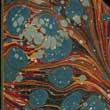 | Dahlia Wolfe: not listed Muira: Dahlia The pattern was created during the end of the 19th century. The pattern is created by starting with a Zebra base. Next according to Muira, another color mixed with ox gall is thrown onto the bath. Then a second color is then ‘swirled’ through a sieve onto the bath. As a final step, a third color is then lightly sprinkled onto top, creating flower-like patterns to occur which are reminiscent of the Dahlia. (Muira pg 84) » View Examples |
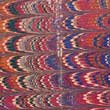 | Double comb Wolfe: Double comb pattern Muira: Muira does not offer a separate name for this pattern; instead he includes an example of it when he illustrates the Nonpareil marble. Maurer-Mathison: Double Nonpareil. This pattern is created by first making a standard Nonpareil pattern. Once this is done, a final comb with one set of teeth set in wider intervals than was used in the Nonpareil is drawn once more through the bath. This last step causes the numerous, arched lines to be broken into separate, arched columns. (Wolfe plate XXV 31-32 ; Muira pg 93 (illustration B) ; Maurer-Mathison pg 80) » View Examples |
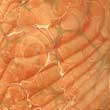 | Double marble Wolfe: not listed Muira and Schleicher: Double marble Though related, a Double marble is not the same process as an ‘Overprint’ (Wolfe plate XXXVII 180). The first instance of Double marbling was seen in the 17th century. A Double marble is created when, after the first desired pattern is completed and the paper dried, the same paper is again treated with Alum and marbled with the second pattern over the top of the first. (Muira pgs 120-121 ; Schleicher pgs 130-131) » View Examples |
 | Extra (Alternative pattern names: Drag, Allongé, Tiré, Schleppmuster, Zugmuster) Wolfe: Extra Muira: Drag This pattern was first created in the 19th century. This pattern is similar to the British (Muira pg 51) and Spanish Drag (Wolfe plate XXXVI 167) patterns. The British pattern is distinguishable because of its strong tendency towards use of darker colors not associated with a regular Extra or Drag marble. The Spanish Drag is simply an Extra pattern with the addition of the gradated linear work, characteristic of the Spanish pattern. This pattern is created by starting with a Turkish base then once the paper is laid onto the bath to be pulled it is dragged forward, elongating the spots. (Wolfe plate XXXVI 166 (Extra) ; Muira pg 50 (Drag)) » View Examples |
 | Fantasy (Alternative pattern names: Fancy, Maître-Relieur, Fantaisie, Phantasie) Wolfe: Although Wolfe does not address this pattern name he does show an oil-based ink sample of it. Muira: Fantasy marble This is a more modern pattern created sometime between the end of the 19th and early 20th centuries. It is because of the this pattern's use of thin size, which causes its lines and spots to remain unsmooth, that it could be misinterpreted and thought to be a marble made with oil-based inks which share similar spotting and irregular line work. The pattern is created, according to Muira, by starting with a Turkish base using a very thin size or pure water. A stylus would then be used to drawn the colors into the desired shapes. Generally, the shapes created in a Fantasy marble are less structured and formal than you would see in a regular marbled pattern. (Wolfe plate XXXVIII 188 ; Muira pgs 69-71) » View Examples |
 | Fountain (Alternative pattern names: Peigne Fontaine, Springbrunnen) Wolfe: not listed Muira: Fountain This pattern is created by starting with a Turkish base. A comb with one set of teeth is then drawn back and forth, across the bath (Muira) causing the spots to have the appearance of gushing water. (Muira pg 89) » View Examples |
 | French Curl (Alternative name: Snail, Curl, Escargot, Tourniquet, Coquille, Schnecken) Wolfe: French Curl Muira: Snail This pattern is created when any base pattern desired is completed. Next an individual stylus or comb with one set of teeth set in width intervals would be inserted into the bath and swirled, completing the French Curl aspect. (Wolfe plates XXXV 145-150 (French Curl) ; Muira pgs 76-77 (Snail)) » View Examples |
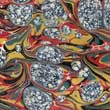 | Gloster (Alternative pattern names: Gloucester, Partidge's Eye, Oeil de Perdrix, Stein Marmor mit Grießtropfen) Wolfe: Although Wolfe does provide an example of this pattern he only acknowledges where the example was made (Gloucester) rather than suggesting this is the name of the pattern itself. Muira: Gloster This pattern is similar to and often mistaken for a Stormont pattern. Both of these patterns employ the use of a dispersant such as turpentine to cause their distinctive white (open) spots. The difference is that the Stormont pattern, overall, appears to be more like a Turkish pattern in that the ink has been mixed with the dispersant to cover the entire surface, whereas the Gloster looks more like a Zebra pattern where the dispersant has only been mixed with a single color, making the spots distinctive from the other colors used. The pattern is created by starting with a Turkish base, then a comb with one set of teeth is drawn across the bath twice vertically (or horizontally), once in either direction with the second pass halving the first. Then one or more colors of ink mixed with a dispersant are sprinkled onto the bath, causing those last spots to have open, very fine spots inside them. (Wolfe plate XXXVI 168 (Gloucester) ; Muira pg 88 (Gloster)) » View Examples |
 | Gold Vein (Alternative pattern names: Vein d’Or, Goldader) Wolfe: not listed Muira: Gold Vein Muira attributes this pattern's creation to the Le Bretons in the 17th century. This pattern is related to the Turkish pattern, the only difference in process being that with a Gold Vein marble there is the initial step of using bronze inks. This pattern is created in the regular Turkish pattern way however the first color to be thrown onto the bath would be bronze ink, ensuring that any following colors would have gold veins running between them. (Muira pg 122) » View Examples |
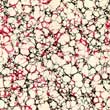 | Italian (Alternative pattern names: Neo-Italian, Vein, Hair Vein, Veiné, Moucheté, Haarader, Ader) Wolfe and Muira: Italian This pattern was created in Italy near the end of the 18th century. Its name is likely based equally on it nation of origin and the fact that it so closely resembles the actual stone, Italian marble. This pattern is created when after however many colors desired are thrown onto the bath. Then a dispersant is sprinkled over the entire bath in fine dots. These tiny drops of dispersant cause the previously thrown colors to constrict into tiny veins. Muira suggests that the dispersant might be made up of a mixture of soap, spirits and ox gall and then sprinkled over the bath through fine wire mesh to maintain the size of the dispersant drops. These constricted veins cause the colors to appear as they would in marbled stone. (Wolfe plates XXXVI 157-159 ; Muira pg 52) » View Examples |
 | Morris Wolfe: not listed Muira: Morris This pattern's origin dates from the end of the 19th century. Muira suggested it may have been created by E.W. Morris who was a printer in London or possibly by a gentleman named Morris who worked in Oxford. The pattern is created in a manor unlike the traditional western style of marbling. A paper is soaked with water by a sponge. Then colors are dropped onto the paper. Because the paper is already wet the colors dropped onto it run into one another in a sort of watercolor effect. Muira suggests that if the creator desires it the paper can be moved in such a way as to guide the flow of the colors on the page. This particular pattern can easily be done using this water-based process as well as oil-based ones. (Muira pg 140) » View Examples |
 | Nonpareil (Alternative pattern names: Peigné Droit, Kamm) Wolfe and Muira: Nonpareil The name for this pattern is a French word which translated means ‘matchless’ or ‘unrivalled.’ This pattern is related to the Wide comb (Arch) pattern as well as the Old Dutch pattern. All are variations of one another and are often mistaken for each other. The major differences are very difficult to pinpoint, but seem to stem from the size of intervals the last comb's teeth are set in. This pattern is created when the desired colors are dropped sequentially onto the bath using some sort of implement to regulate the drop sizes. According to Muira a comb with one set of teeth set at intervals of 15-30mm is drawn through the bath horizontally, once in either direction with the second pass halving the first. Then another comb with teeth set at 2-3 mm is drawn once across the bath vertically (or horizontally). (Wolfe plate XXIX 145-150 ; Muira pgs 92-93) » View Examples |
 | Overprinted Wolfe: Overprinted Muira: not listed This is related to but not the same as a Double marble. A Double marble is when a single sheet of paper has been marbled, dried and that same paper has been marbled again on the same side. Overprinted is when a paper has been marbled and then a second marble is done over the first by a lithographic process. Note that the first pattern may have been printed as well rather than being done on a bath. (Wolfe plate XXXVII 180 (Gold vein overprinted)) » View Examples |
 | Papier Croisé (Alternative pattern name: Twilled paper) Wolfe: Papier Croisé Muira: not listed This pattern is amongst the d’Annonay papiers attributed by Wolfe (pg 113) to F.M. Montgolfier beginning around 1830. This pattern is amongst those marbled papers which Wolfe designates “pseudo-marbling,” historically assigned the name Agathe or Achate (Agate) and more currently been called Bench papers. This pattern is created when a paper, treated with potassium hydroxide or caustic potash, is laid out on a flat surface. The colors used would be the same as those for other marbled papers only here would be mixed with starch and alum. The colors would then be applied to the paper either by sprinkling them on or sponging them on. When making a Papier Croisé, the final step requires that the paper be lifted up and shifted in turns while still wet. This final step allows the colors run and mix, causing the characteristic “twists and turns in the design.” (Wolfe pg 114). (Wolfe plate XXI 1-3) » View Examples |
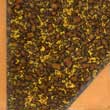 | Papier Tourniquet (Alternative pattern names: German, Gustav, Gustave) Wolfe: Papier Tourniquet Muira does not have an example of this specific pattern but does have one which is of the same time period and which is closely related in its look and creation, the German (Gustav) marble. Muira acknowledges however, the relationship between the two patterns by identifying other known names for it as Papier Annonay and Gustave Marmor. Wolfe identifies this as amongst the three styles of d’Annonay papiers, distinguishing them as amongst the two categories of ‘imitation or pseudo-marbled’ (not made in a bath) papers attributed to French creation. Wolfe paraphrasing M. Fichtenberg also suggests that both the Germans and the French made versions of each others’ ‘pseudo-marbles’ at the same time so discerning the absolute country of origin varies often. According to Muira's related pattern (German, Gustav) this is most likely created when a piece of paper laid out on a flat surface is coated with a color. Then marbling brushes would be used to sprinkle color directly onto the surface causing the characteristic spots of dispersed (bleeding) ink to be absorbed into the paper. (Wolfe plate XX 4-7 (Papier Tourniquet) ; Muira pgs 134-135 (German)) » View Examples |
 | Papier Coulé (Alternative pattern names: Trickle, Riesel, Sliding paper) Wolfe: Papier Coulé Muira: Trickle Papier Coulé is one of the three types of Annonay papiers. Identifying this amongst the three styles of Annonay papiers distinguishes them as amongst the two Wolfe categories of ‘imitation or pseudo-marbled’ papers attributed to French creation (Wolfe paraphrasing M. Fichtenberg also suggests that both the Germans and the French made versions of each others’ pseudo-marbles at the same time so discerning the absolute country of origin varies often). All three of the Annonay papiers were, according to Wolfe, created in the same basic way though their end results came from the way in which they were finished be it splattered, sponged, etc. Papier Coulé is related to the other Annonay papers but is closest in appearance and creation to Papier Croisé. The difference being that in a Croisé the wet paste is allowed to trickle in multiple directions whereas a Coulé is only run in a single direction. This pattern is created when a paper laid on a flat surface is covered with a thin application of colored paste. A second, diluted color of paste would then be sprinkled onto the surface of the paper. The paper would then be attached to a board and tilted at an angle. The angle allows the still wet paste colors to run or ‘trickle’ causing the pattern to form. (Wolfe plate XX 8-9 ; Muira pg 137) » View Examples |
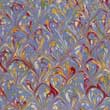 | Peacock (Alternative pattern names: Pfauen, Plume de Paon, Queue de Paon, Augen) Wolfe: Peacock Muira: Bouquet The Peacock pattern is similar to and easily confused with the Bouquet pattern. According to Wolfe's usage of the term, Peacock is more about the process in making of the pattern where as Muira implies that Peacock and Bouquet, while similar in repeating shape, each always has a standard base, Peacock's being Turkish, and Bouquet's being Nonpareil. Many other artists agree, consequently, these two names have often been used interchangeably. According to Muira this pattern is created by starting with a Turkish base. A comb with one set of teeth would be drawn through the bath twice vertically, once in either direction with the second pass halving the first. This step would then be repeatedly horizontally. The final step would be to draw a comb with two sets of teeth through the bath vertically in loose, wave-like lines. This last pass causes loop-like shapes to emerge reminiscent of the ends of Peacock feathers. (Wolfe plates XXV 25, XXXV 151-153 ; Muira pg 117) » View Examples |
 | Placard (Alternative pattern name: Drawn Stone) This is most likely an example of the Placard as exampled by Wolfe. Miura: not listed Wolfe suggests the Placard pattern is one amongst those which were first created and used for book decoration in France between 1680 and 1740. These patterns have been grouped because of their dominating popularity, called “la vulgarization du papier marbré.” (The word vulgarization in this instance does not have a negative connotation but instead refers to its common usage.). The creation method of this pattern goes un-described by Wolfe. It appears to be a combination of elements found singled out and characteristic of other, later patterns. For example colors added in the Turkish pattern manner, with some light combing as seen in the Antique Straight or Dahlia marbles as well as some swirls reminiscent of the French curl pattern. In overall appearance and creation this antique pattern is closest to the modern Drawn Stone pattern as described and exampled by Schleicher. (Wolfe plates XXIII 1-4, XXV 26 ; Schleicher pgs 32-33) » View Examples |
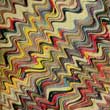 | Polnisch (Alternative pattern names: Polish, Polonais) Wolfe: Polnisch Muira: not listed This pattern was developed in the 1830's and considered to be (as Wolfe describes it) a fantasy paper. As Fichtenberg describes through Wolfe (pg 187) “it was an elegant design, especially when shaded (sample 119) to form what was called “trocadero.” This pattern is created when a several colors are sprinkled onto the bath then worked into long straight lines of mixing colors by raking through the bath. “The pattern's special appearance depended on the manner that the paper was laid down, not smoothly and in one continuous motion in the usual way, but by drawing the paper back and forth with small hand movements.” (Wolfe plate XXXII 119) » View Examples |
 | Romantic (Alternative pattern names: Broken, Gravel, Marbres Cassé, Grieß Marmor) Wolfe: Romantic (sometimes he refers to it as Broken) pattern Muira: Gravel marble. Historically, (as both Wolfe and Muira agree) that it has been known as Marbre Cassé. This pattern was created in Germany in the 18th century. This pattern is created (according to Wolfe) by adding to the ground color, traditionally a ground color (like Cassel earth), a mixture referred to as ‘glazing paste.’ The exact ingredients for this are not exactly the same between Wolfe and Muira but both agree that it had caustic elements which caused the ‘breaking’ to occur. Wolfe describes its creation: “Two troughs, both containing tragacanth size, were employed in tandem. After the vein colors had been sprinkled on and the ground color laid onto one trough, the operator shifted to the second trough and repeated the same operation, by which time the pattern on the first trough had broken up.” Wolfe is suggesting in this statement that a brief interval was necessary for the reaction to take place. Muira says that the pattern is created when after the first color (which will become the veins) is thrown onto the size, the following colors are thrown after they are mixed with ox gall, tartaric acid, wax and caustic soda. This mixture with the ink would be what caused the breaking up of the ink on the surface of the size. (Wolfe plate XXXII 115-117 (Romantic) ; Muira pg 58 (Gravel)) » View Examples |
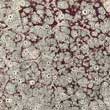 | Schrottel (Alternative pattern names: Scrotel, Schroëtel, Schroffel, Schrot) Wolfe: Schrottel Muira: Scrotel The pattern was created in Germany in the early part of the 18th century. It has many different spellings but Muira suggests in his spelling that the pattern's name is derived from the German word Schrot which means ‘small shot’ or ‘small grain.’ The pattern is created by starting with a Turkish base. Then, you would throw a mixture onto the bath whose reaction with the previous colors causes the dark spots with white halos to appear which are reminiscent in look to tiny stones. This mixture is made up of ox gall and oil (Muira, pg 53). (Wolfe plate XXXII 112-114 ; Muira pg 53) » View Examples |
 | Serpentine (Alternative pattern names: Peigné Serpentin, Gewunden Gekämmter, Waved, Wave) Wolfe: not listed (parts of this pattern can be seen in pieces Wolfe refers to -Wide comb and waved) Muira: Serpentine This Serpentine, according to Muira, was first created in the middle of the 19th century. The pattern is created by starting with a Turkish base. A comb with one set of teeth is drawn through the bath twice vertically, once in either direction with the second pass halving the first. This step is repeated horizontally. Then the final step is to draw a comb, with one set of teeth set at slightly wider intervals, through the bath once vertically in wavy lines reminiscent of the way in which a snake moves. (Muira pgs 107-109 ;Wolfe plates XXIII 10 (Wide comb), XXXV 154 (waved) » View Examples |
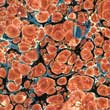 | Shell (Alternative pattern names: French Shell, Caillouté Agate, Ringader, Vogelaugen) Wolfe and Muira: Shell This pattern's creation dates back to sometime near the end of the 18th century in France. This pattern is created in a similar way to a Turkish pattern. Once the desired colors have been chosen they can be sprinkled onto the bath. Whichever of those colors is picked to be the final color dropped or at least the most dominate color to be included is the one which would be mixed with oil before being sprinkled onto the bath. The addition of the oil in the color causes the characteristic white outline to appear and the pigment to become darker towards the center of the drop. (Wolfe plate XXX 88-96 ; Muira pgs 54-55) » View Examples |
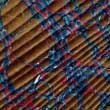 | Spanish (Alternative pattern names: Wellen, Griechisch, Ombre Droit, Espagñol) Wolfe and Muira: Spanish The pattern was created at the beginning of the 17th century. Marbling lore has suggested (Loring) that it was discovered when a marbler's assistant who was nursing a hangover and had shaky hands, laid the paper into the bath (to pull up a finished paper) and as a consequence of the unsteady hands pulled a pattern with the linear, gradated lines characteristic of this pattern. The pattern is created typically by starting with a Turkish base, then as the paper is laid onto the bath it is agitated back and forth in regular motions, repeatedly. (Wolfe plate XXXIV 135-137 (Spanish with plain Turkish base) ; Muira pgs 64-65) » View Examples |
 | Spanish moiré Wolfe and Muira: Spanish moiré This pattern is related to and a variation of the (typical) Spanish marble. It was created about the same time at the beginning of the 17th century. According to Muira the pattern is created starting with a Turkish base. A paper which has been folded in half diagonally and vertically (or horizontally and vertically) is laid onto the bath, moving slightly from side to side to create the curvilinear, gradations typical of this pattern. (Wolfe plate XXXIV 143-144 ; Muira pg 66) » View Examples |
 | Stormont (Alternate pattern names: French, Empire) Wolfe and Muira: Stormont Muira says that there is a district in Blefast, Nothern Ireland by this name but does not suggest that this is the pattern's place of origin but rather in Dublin in 1750. Wolfe attributes the patterns’ creation to the French during the beginning of the 19th century. This pattern is related to and can be mistaken for the Gloster marble. There are two noticeable differences between the two patterns. One being that the Gloster employs the use of a dispersant mixed with one or more colors which are confined to specific areas whereas in a Stormont the dispersant tends to cover the entire bath. The second and more distinguishing difference is that a Gloster pattern characteristically has a combed base whereas a Stormont would typically have a Turkish base. This pattern is created starting with a Turkish base. One or more colors would then be mixed with a dispersant, such as turpentine, and thrown onto the bath. These dispersant-mixed colors will appear to be covered with tiny holes. When making this pattern you must work faster than usual to pull the marble because the turpentine will evaporate, closing up this lacy network of holes. (Wolfe plate XXIX 73-84, XXX 85-87 ; Muira pgs 56-57) » View Examples |
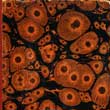 | Tiger (Alternative pattern names: Sun Spot, Soleil, Oeil de Chat, Oeil de Tigre, Sonnen, Tigeraugen) Wolfe: Tiger Muira: Sun This pattern was created in approximately 1855. According to Muira this pattern is created by dropping two or three colors onto the bath. Then a final color (usually black) is mixed with ‘kreolin’, lime water and potash solution is thrown onto the bath. This last colors’ chemical solution causes the spots to react in such a way as to appear like eyes with dark irises at the center from which tiny rays of the same color to spread out around it. (Wolfe plate XXXII 109-111 ; Muira pgs 80-81) » View Examples |
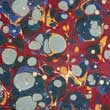 | Turkish (Alternative pattern name(s): Spot, Stone, Agate, Stein, Achat, Caillouté Simple) Wolfe and Muira: Turkish Historically, this is the oldest of Western marbled patterns and dates back to as early as the middle part of the 15th century. This pattern is created when one or more colors are thrown onto the surface of the bath using a marbling brush. The first colors thrown tend to constrict as other follow and become the ‘vein’ colors for the latter thrown inks. (Wolfe plate XXVI 44-48 ; Muira pgs 47-49) » View Examples |
 | Wide Comb (Alternative pattern names: Arch, Peigne d’Arc, Bogen) Wolfe: Wide comb Muira: Arch This pattern is created starting with a Turkish base, probably where the colors were dropped onto the bath sequentially. A comb with one set of teeth set in somewhat narrow intervals is drawn across the bath twice horizontally, once in either direction with the second pass halving the first. Then another comb whose teeth are set at much wider intervals is drawn through the bath once vertically causing the arches to form. (Wolfe plate XXIII 10 (Wide comb) ;Muira pg 91 (Arch)) » View Examples |
 | Zebra (Alternative pattern names: Zèbre, Gezogener Achat) Wolfe and Muira: Zebra This pattern was popular at the end of the 19th century. This pattern is related closely to and could be mistaken for an Antique Straight pattern. Both begin the same way however, in the Zebra pattern the final sprinkled colors are usually quite large drops, whereas in the Antique Straight the final drops are more uniform and tend to be finer dots as one would see in any pattern that has been ‘Anitiqued.’ This pattern is created by starting with a Turkish base. A comb with one set of teeth is then drawn through the bath twice vertically, once in either direction with the second pass halving the first. The last step is to sprinkle or splash on one or more colors. (Wolfe plate XXXVI 160 ; Muira pg 83) » View Examples |
Monday, October 21, 2013
Oxford: At the Clarendon Press
"One
may say that there is no adequate reason why a university press should
confine itself to works of scholarship which have very little chance of
paying for themselves; and that, for instance, the Oxford University
Press publishes miscellaneous books. But not all books bearing the
Oxford University Press imprint are of necessity scholarly books.
Responsibility for scholarship, format, etc., is indicated by the
special imprint, "Oxford: At the Clarendon Press." This has a special
meaning, which is that books like Thompson's Greek and Latin Paleography, McKerrow's Introduction to
Bibliography, or Murray's Aeschylus, The Creator of Tragedy are published by the authority of the University, and the contents as well as form are certified by the University through the delegates of the Press. In other words, the imprint "Oxford: At the Clarendon Press" is the hall-mark of scholarly work. The imprint "Oxford University Press" does not imply that the books bearing it have necessarily a relation to the University delegates. It is the imprint of a publishing house of very high repute whose English publications are printed at the University Press, Oxford. At the Cambridge University Press there is not the same division of responsibility as at Oxford. Every book published by the Cambridge Press has the approval of the syndics as to its contents."
Bibliography, or Murray's Aeschylus, The Creator of Tragedy are published by the authority of the University, and the contents as well as form are certified by the University through the delegates of the Press. In other words, the imprint "Oxford: At the Clarendon Press" is the hall-mark of scholarly work. The imprint "Oxford University Press" does not imply that the books bearing it have necessarily a relation to the University delegates. It is the imprint of a publishing house of very high repute whose English publications are printed at the University Press, Oxford. At the Cambridge University Press there is not the same division of responsibility as at Oxford. Every book published by the Cambridge Press has the approval of the syndics as to its contents."
Daniel Berkeley Updike
From the essay:
"American University Presses" in
"Some Aspects of Printing Old and New"
Publisher William Edwin Rudge, New Haven 1941
View and/or purchase this book @ My Bookstore
Thursday, August 29, 2013
The Whaleman and Other Sea-Songs: New Bedford History
Scarce pamphlet, large grey cover with black writing, staplebound. Contents: Photo of Spollon, Intro, photo of the statue, The Whaleman, and 13 other poems. Published as a souvenir for the 1913 unveiling of the statue of the Whaleman on the grounds of the Free Public Library to the City of New Bedford, on June 20, 1913. Illustrates the power of poetry. In 1903 Spollon published the poem 'The Whaleman' in the Boston magazine 'Fiber and Fabric', first suggesting the Whaleman statue: 'Yet I heartily wish his old shape could be seen, In marble or bronze, mounted here on the green...For in this town he'll soon be a stranger.' Though a popular idea, the city of New Bedford had other priorities for its expenditures. In 1913 private citizen William W. Crapo commissioned and donated the statue to New Bedford.
View and/or purchase this book @ My Bookstore
Subscribe to:
Posts (Atom)





